check oil OLDSMOBILE SILHOUETTE 1995 Owners Manual
[x] Cancel search | Manufacturer: OLDSMOBILE, Model Year: 1995, Model line: SILHOUETTE, Model: OLDSMOBILE SILHOUETTE 1995Pages: 390, PDF Size: 20.27 MB
Page 204 of 390
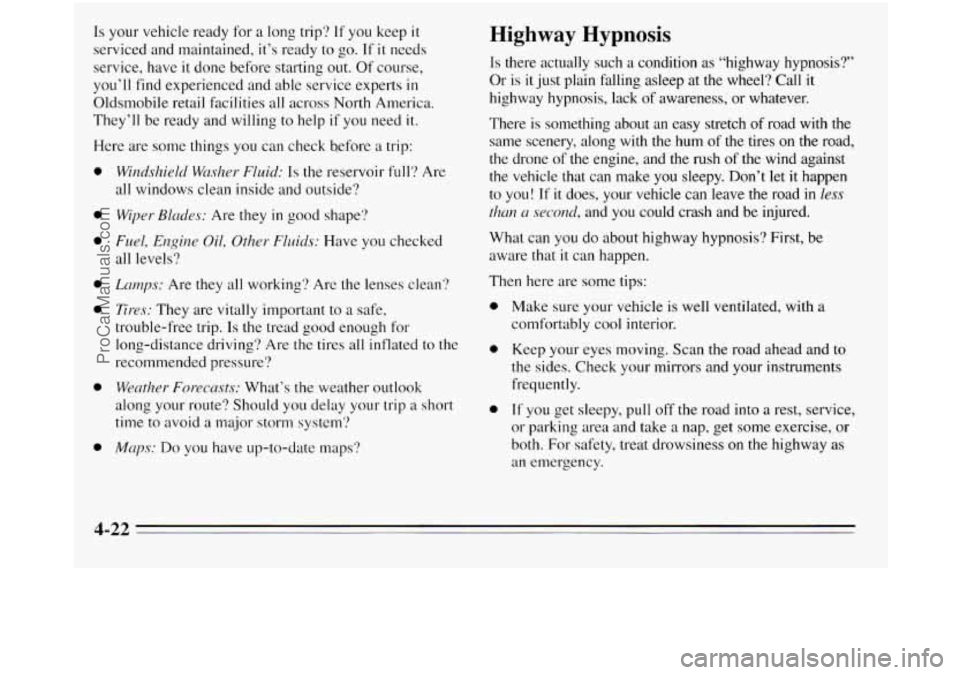
Is your vehicle ready for a long trip? If you keep it
serviced and maintained, it’s ready to go. If it needs
service, have
it done before starting out. Of course,
you’ll find experienced and able service experts in
Oldsmobile retail facilities all across North America.
They’ll be ready and willing
to help if you need it.
Here are some things you can check before a trip:
0
a
a
0
a
a
0
Windshield WLzslzer Fluid: Is the reservoir full? Are
all windows clean inside and outside?
Wiper Blades: Are they in good shape?
Fuel, Engine OiL, Other Fluids: Have you checked
all levels?
Lcmys: Are they all working? Are the lenses clean?
Tires: They are vitally important to a safe,
trouble-free trip.
Is the tread good enough for
long-distance driving? Are
the tires all inflated to the
recommended pressure?
Weather Forecasts: What’s the weather outlook
along your route? Should
you delay your trip a short
time to avoid a major storm system‘?
Maps: Do you have up-to-date maps‘?
Highway Hypnosis
Is there actually such a condition as “highway hypnosis?’
Or is it just plain falling asleep at the wheel? Call it
highway hypnosis, lack
of awareness, or whatever.
There
is something about an easy stretch of road with the
same scenery, along with the hum of the tires on the road,
the drone of the engine, and the rush
of the wind against
the vehicle that can make you sleepy. Don’t
let it happen
to you! If
it does, your vehicle can leave the road in less
than u second, and you could crash and be injured.
What can you do about highway hypnosis? First, be
aware that it can happen.
Then here are some tips:
0
0
0 Make sure your vehicle is well ventilated, with a
comfortably cool interior.
Keep your eyes moving. Scan the road ahead and
to
the sides. Check your mirrors and your instruments
frequently.
If you get sleepy, pull
off the road into a rest, service,
or parking area and take
a nap, get some exercise, or
both. For safety, treat drowsiness on the highway as
an emergency.
4-22
ProCarManuals.com
Page 220 of 390
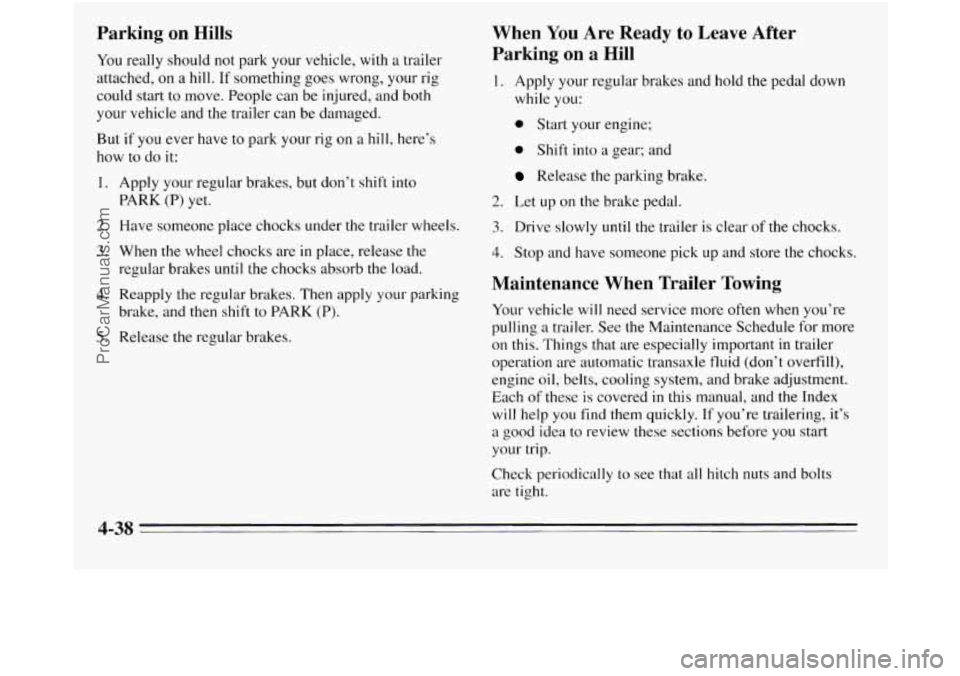
could start to move. People can be injured, and both
your vehicle and the trailer can be damaged.
But
if you ever have to park your rig on a hill, here’s
how to
do it:
1. Apply your regular brakes, but don’t shift into
PARK
(P) yet.
2. Have someone place chocks under the trailer whe
3. When the wheel chocks are in place, release the
regular brakes until the chocks absorb the load. els.
Parking on Hills
You really should
not park your vehicle, with a trailer
attached, on
a hill. If something goes wrong, your rig
4. Reapply the regular brakes. Then apply your parking
brake, and then shift to PARK
(P).
5. Release the regular brakes.
When You Are Ready to Leave After
Parking
on a Hill
1. Apply your regular brakes and hold the pedal down
while you:
0 Start your engine;
0 Shift into a gear; and
Release the parking brake.
2. Let up on the brake pedal.
3. Drive slowly until the trailer is cl
ear of the chocks.
4. Stop and have someone pick up and store the chocks.
Maintenance When Trailer Towing
Your vehicle will need service more often when you’re
pulling
a trailer. See the Maintenance Schedule for more
on this. Things that are especially important in trailer
operation are automatic transaxle fluid (don’t overfill),
engine
oil, belts, cooling system, and brake adjustment.
Each
of these is covered in this manual, and the Index
will help you find them quickly. If you’re trailering, it’s
a good idea to review these sections before you start
your trip.
Check periodically to see that
all hitch nuts and bolts
are tight.
4-3s
ProCarManuals.com
Page 264 of 390
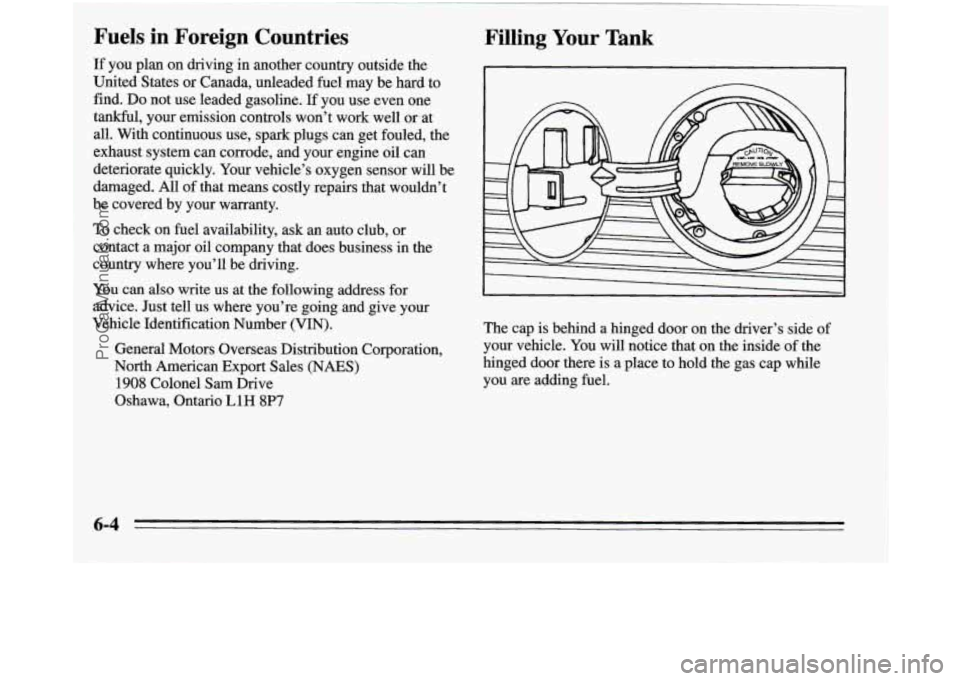
~~~ Fuels in Foreign Countries
If
you plan on driving in another country outside the
United States or Canada, unleaded
fuel may be hard to
find. Do not use leaded gasoline.
If you use even one
tankful, your emission controls won’t work well or at
all. With continuous use, spark plugs can get fouled, the
exhaust system can corrode, and your engine oil can
deteriorate quickly. Your vehicle’s oxygen sensor will be
damaged. All of that means costly repairs that wouldn’t
be covered by your warranty.
To check on fuel availability, ask an auto club, or
contact a major oil company that does business in the
country where you’ll be driving.
You can also write us at the following address for
advice. Just tell us where you’re going and give your
Vehicle Identification Number (VIN).
General Motors Overseas Distribution Corporation,
North American Export Sales (NAES)
1908 Colonel Sam Drive
Oshawa, Ontario
L1H 8P7
Filling Your Tank
The cap is behind a hinged door on the driver’s side of
your vehicle.
You will notice that on the inside of the
hinged door there is a place to hold
the gas cap while
you are adding fuel.
6-4
ProCarManuals.com
Page 271 of 390
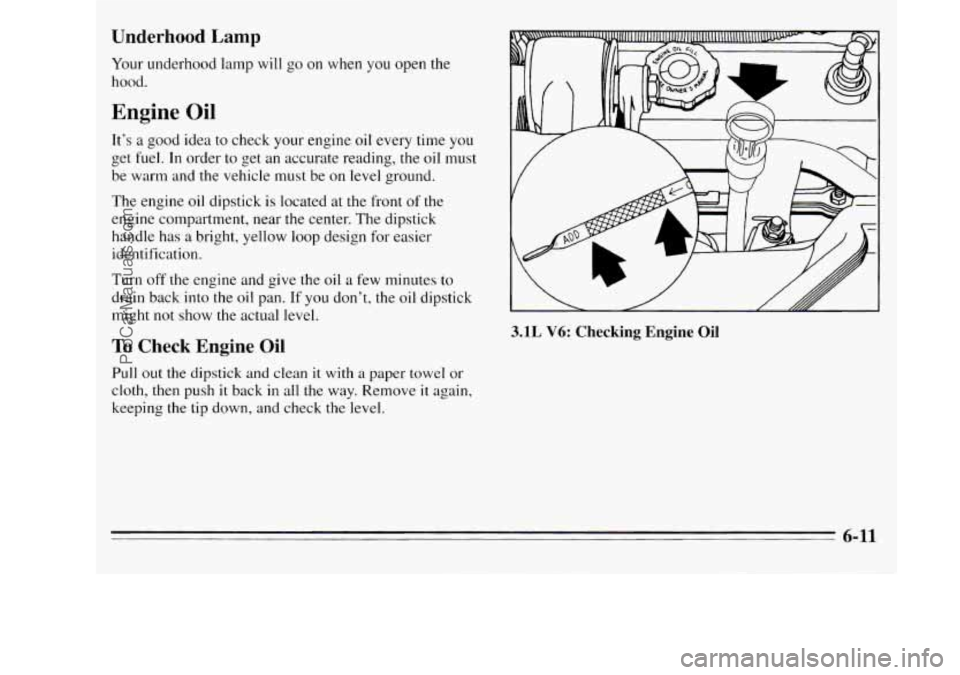
Underhood Lamp
Your underhood lamp will go on when you open the
hood.
Engine Oil
It’s a good idea to check your engine oil every time you
get fuel. In order to get an accurate reading, the oil must
be warm and the vehicle must be on level ground.
The engine oil dipstick is located at the front of the
engine compartment, near the center.
The dipstick
handle has
a bright, yellow loop design for easier
identification.
Turn off
the engine and give the oil a few minutes to
drain back into the
oil pan. If you don’t, the oil dipstick
might not show
the actual level.
To Check Engine Oil
Pull out the dipstick and clean it with a paper towel or
cloth, then push
it back in all the way. Remove it again,
keeping the tip down, and check the level.
I/
I
3.1L V6: Checking Engine Oil
6-11
ProCarManuals.com
Page 279 of 390
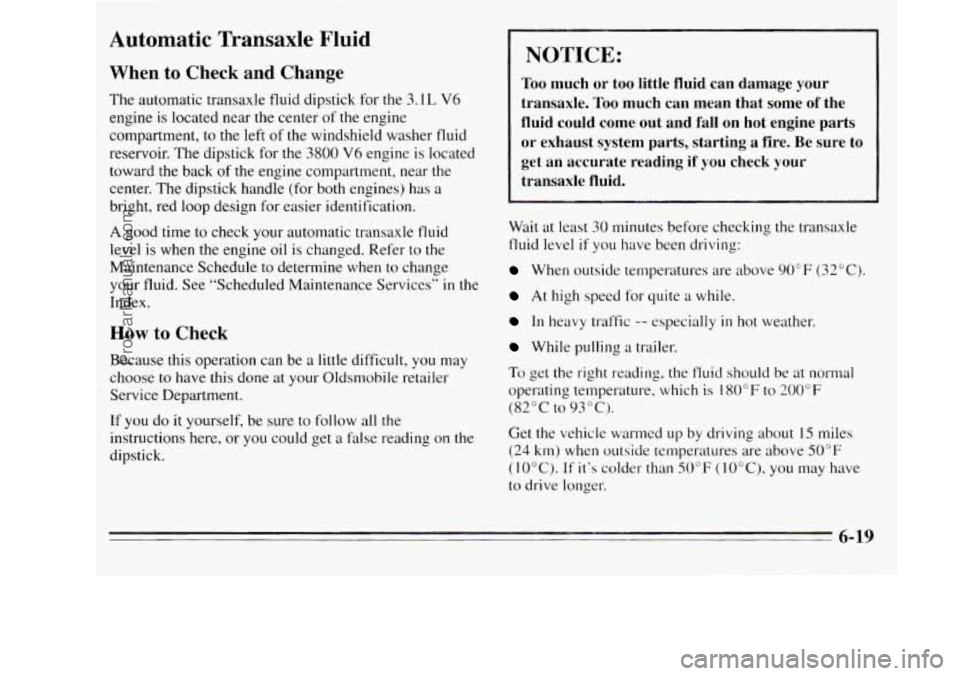
Automatic Transaxle Fluid
When to Check and Change
The automatic transaxle fluid dipstick for the 3.1 L V6
engine is located near the center of the engine
compartment, to the left
of the windshield washer fluid
reservoir. The dipstick for
the 3800 V6 engine is located
toward the back
of the engine Compartment, near the
center. The dipstick handle (for both engines) has
a
bright, red loop design for easier identification.
A good time to check your automatic transaxle fluid
level is when the engine oil is changed. Refer to the
Maintenance Schedule to determine when to change
your fluid. See “Scheduled Maintenance Services”
in the
Index.
How to Check
Because this operation can be a little difficult, you may
choose to have this done at your Oldsmobile retailer
Service Department.
If
you do it yourself, be sure to follow all the
instructions here, or
you could get a false reading on the
dipstick.
NOTICE:
Too much or too little fluid can damage your
transaxle.
Too much can mean that some of the
fluid could come out and fall on hot engine parts
or exhaust system parts, starting a fire. Be sure to
get
an accurate reading if you check your
transaxle fluid.
Wait at least 30 minutes before checking the transaxle
fluid level
if you have been driving:
When outside temperatures are above 90°F (32°C).
At high speed for quite a while.
In heavy traffic -- especially in hot weather.
While pulling a trailer.
To get the right reading, the fluid should be at normal
operating temperature, which is 180°F
to 200°F
(82°C to 93°C).
Get the vehicle warmed up by driving about 15 miles
(24 km) when outside temperatures are above 50°F
(10°C).
If it’s colder than 50°F (lO°C), you may have
to drive longer.
ProCarManuals.com
Page 326 of 390
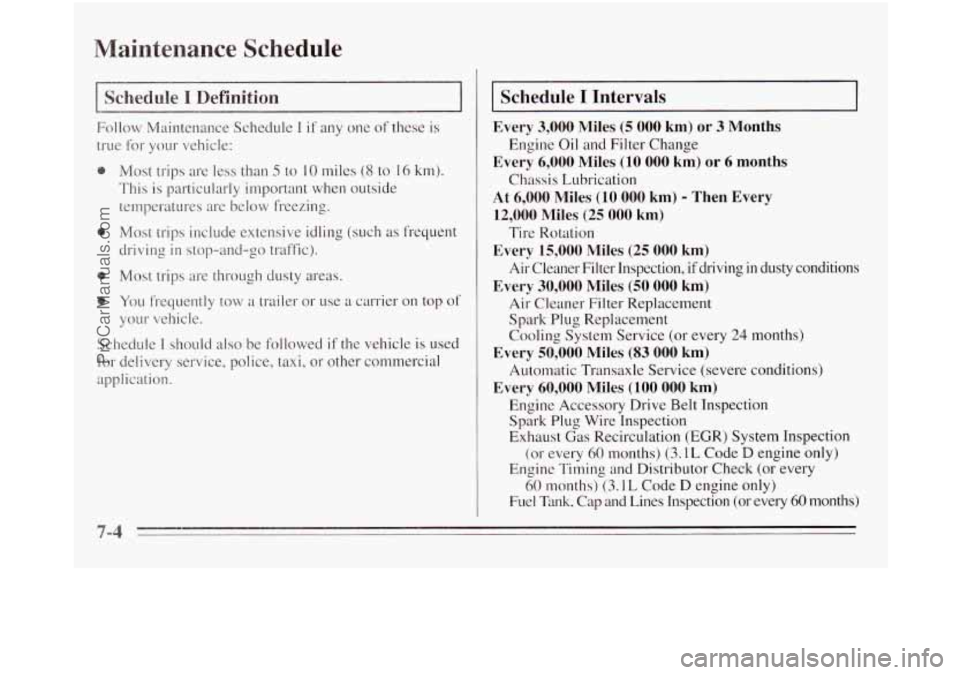
Maintenance Schedule
I Schedule I Definition I
Follow Maintenance Schedule I if any one of these is
true for your vehicle:
0 Most trips are less than 5 to 10 miles (8 to 16 km).
This is particularly important when outside
temperatures are below freezing.
0 Most trips include extensive idling (such as frequent
driving in stop-and-go traffic).
0 Most trips are through dusty areas.
0 You frequently tow a trailer or use a carrier on top 0.f
your vehicle.
Schedule
I should also be followed if the vehicle is used
for delivery service, police, taxi, or other commercial
application.
Schedule I Intervals
Every 3,000 Miles (5 000 km) or 3 Months
Engine Oil and Filter Change
Every 6,000 Miles (10 000 km) or 6 months
Chassis Lubrication
At 6,000 Miles (10 000 km) - Then Every
12,000 Miles (25 000 km)
Tire Rotation
Every 15,000 Miles (25 000 km)
Air Cleaner Filter Inspection, if driving in dusty conditions
Every 30,000 Miles (50 000 km)
Air Cleaner Filter Replacement
Spark Plug Replacement
Cooling System Service (or every
24 months)
Automatic Transaxle Service (severe conditions)
Engine Accessory Drive Belt Inspection
Spark
Plug Wire Inspection
Exhaust
Gas Recirculation (EGR) System Inspection
(or every
60 months) (3.1L Code D engine only)
Engine Timing and Distributor Check (or every
60 months) (3.1 L Code D engine only)
Fuel Tank, Cap and Lines Inspection
(or every 60 months)
Every 50,000 Miles (83 000 km)
Every
60,000 Miles (100 000 km)
7-4
ProCarManuals.com
Page 327 of 390
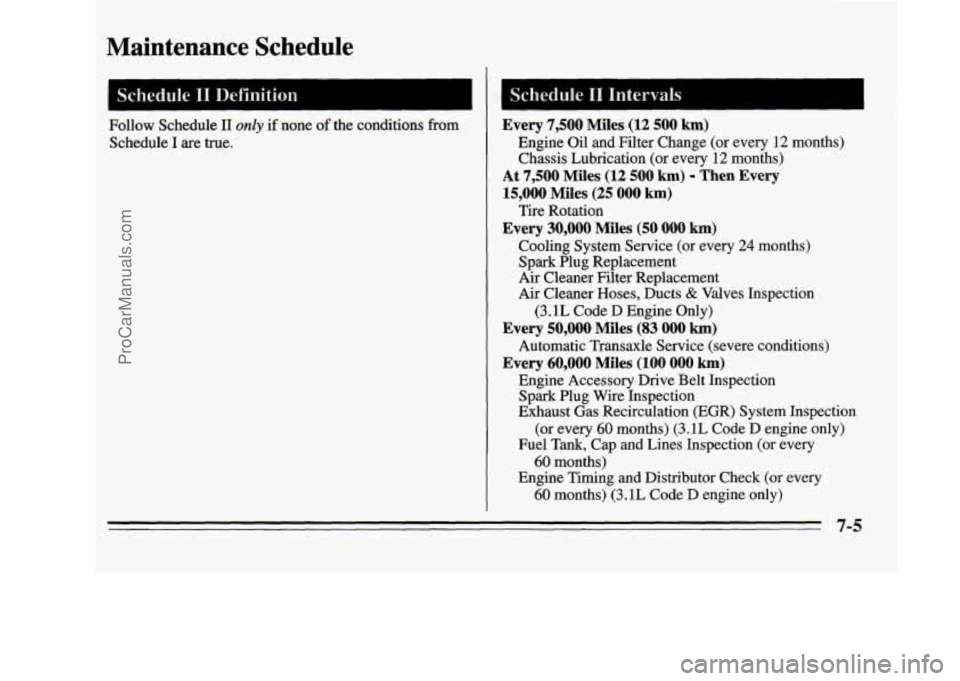
Maintenance Schedule
I Schedule I1 Definition
Follow Schedule I1 only if none of the conditions from
Schedule
I are true.
Every 7,500 Miles (12 500 km)
Engine Oil and Filter Change (or every 12 months)
Chassis Lubrication (or every
12 months)
At 7,500 Miles (12 500 km) - Then Every
15,000 Miles (25 000 km)
Every 30,000 Miles (50 000 km)
Tire Rotation
Cooling System Service (or every
24 months)
Spark Plug Replacement
Air Cleaner Filter Replacement
Air Cleaner Hoses, Ducts
& Valves Inspection
(3.1L Code D Engine Only)
Every 50,000 Miles (83 000 km)
Every 60,000 Miles (100 000 km)
Automatic Transaxle Service (severe conditions)
Engine Accessory Drive Belt Inspection
Spark Plug Wire Inspection
Exhaust Gas Recirculation (EGR) System Inspection
(or every
60 months) (3.1L Code D engine only)
Fuel Tank, Cap and Lines Inspection (or every
60 months)
Engine Timing and Distributor Check (or every
60 months) (3.1L Code D engine only)
7-5
ProCarManuals.com
Page 339 of 390
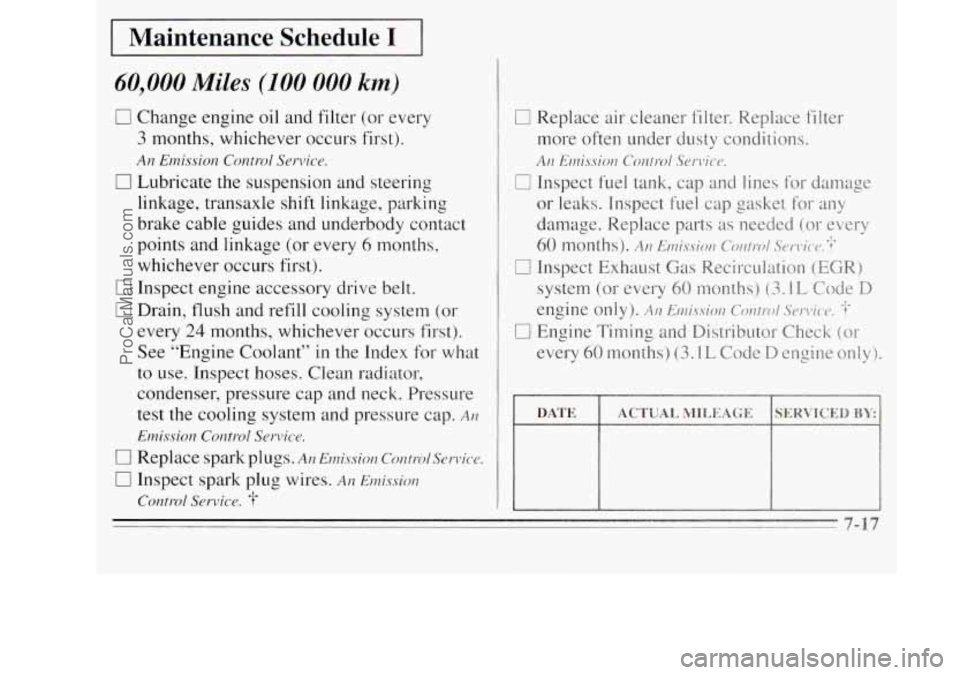
Maintenance Schedule I
60,000 Miles (100 000 km)
0 Change engine oil and filter (or every
3 months, whichever occurs first).
An Emission Contrd Service.
0 Lubricate the suspension and steering
linkage, transaxle shift linkage, parking
brake cable guides and underbody contact
points and linkage
(or every 6 months,
whichever occurs first).
0 Inspect engine accessory drive belt.
0 Drain, flush and refill cooling system (or
every
24 months, whichever occurs first).
See “Engine Coolant”
in the Index for what
to use. Inspect hoses. Clean
radiator,
condenser, pressure cap and neck. Pressure
test the cooling system and pressure cap.
AH
Emission Control Service.
0 Replace spark plugs. An Emission Corltro1Servic.e.
0 Inspect spark plug wires. AI? Emissiolz
Contlvl Service. -t-
0 Replace air cleaner filter. Replace filter
more often under dusty conditions.
An Emission Control Senrice.
0 Inspect fuel tank, cap and lines for damage
or leaks. Inspect
fuel cap gasket for any
damage. Replace parts as needed (or every
60 months). A11 Emis,vioz~ Com-ol Serr?c-e.’I
Cl Inspect Exhaust Gas Recirculation (EGR)
system (or every 60 months) (3.1L Code D
engine only). AI? E111issio1z Corzml Scn!ic.c. -1
0 Engine Timing and Distributor Check or
every 60 months) (3.1 L Code D engine only j.
DATE SERVICED BY: ACTUAL MILEAGE
7-17
ProCarManuals.com
Page 353 of 390
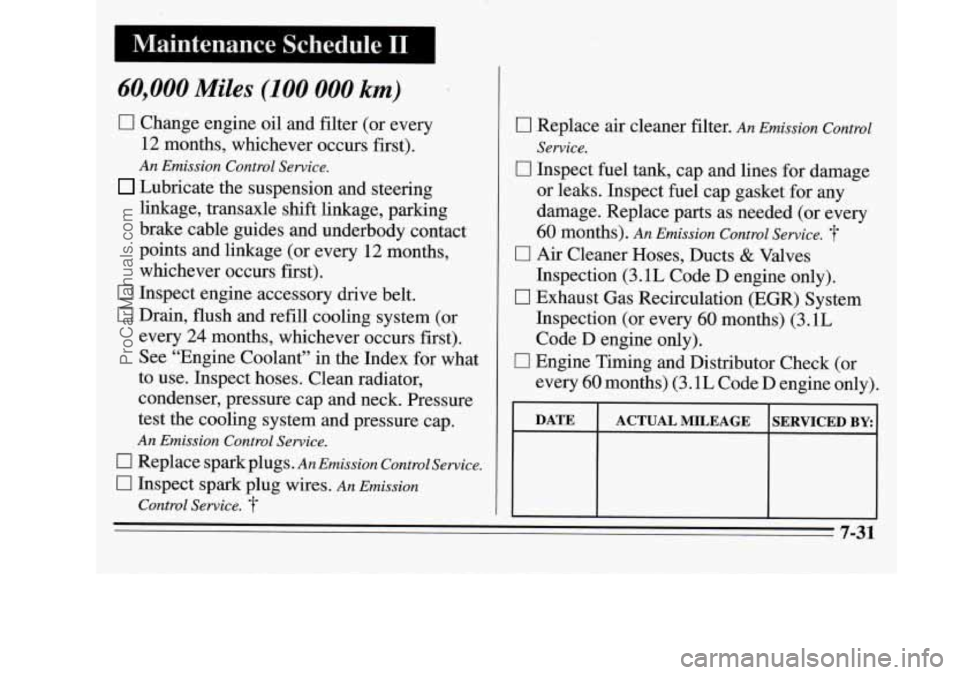
60,000 Miles (100 000 km)
17 Change engine oil and filter (or every
12 months, whichever occurs first).
An Emission Control Service.
Lubricate the suspension and steering
linkage, transaxle shift linkage, parking
brake cable guides and underbody contact
points and linkage (or every
12 months,
whichever occurs first).
0 Inspect engine accessory drive belt.
0 Drain, flush and refill cooling system (or
every
24 months, whichever occurs first).
See "Engine Coolant" in the Index for what
to use. Inspect hoses. Clean radiator,
condenser, pressure cap and neck. Pressure
test the cooling system and pressure cap.
An Emission Control Service.
c] Replace spark plugs. An Emission ControlSewice.
0 Inspect spark plug wires. An Emission
Control Service.
-f-
c
c
1 Replace air cleaner filter. An Emission Control
Service.
1 Inspect fuel tank, cap and lines for damage
or leaks. Inspect fuel cap gasket for any
damage. Replace parts as needed (or every
60 months). An Emission Control Service.
0 Air Cleaner Hoses, Ducts & Valves
Inspection
(3.1L Code D engine only).
0 Exhaust Gas Recirculation (EGR) System
Inspection (or every
60 months) (3.1L
Code D engine only).
0 Engine Timing and Distributor Check (or
every
60 months) (3.1L Code D engine only).
7-31
ProCarManuals.com
Page 358 of 390
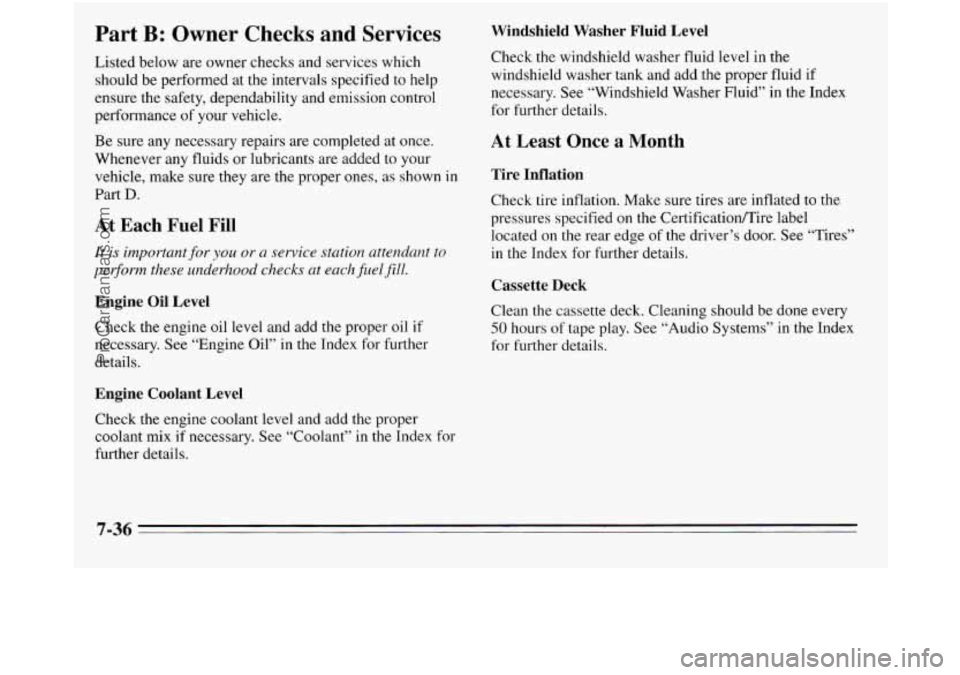
Part B: Owner Checks and Services
Listed below are owner checks and services which
should be performed at the intervals specified to help
ensure the safety, dependability and emission control
performance of your vehicle.
Be sure any necessary repairs are completed at once.
Whenever any fluids or lubricants are added
to your
vehicle, make sure they are the proper ones, as shown in
Part
D.
At Each Fuel Fill
It is important for you or a service stution attendant to
pe$orm these underhood checks at each fueljill.
Engine Oil Level
Check the engine oil level and add the proper oil if
necessary. See “Engine Oil”
in the Index for further
details.
Windshield Washer Fluid Level
Check the windshield washer fluid level in the
windshield washer tank and add the proper fluid if
necessary. See “Windshield Washer Fluid” in the Index
for further details.
At Least Once a Month
Tire Inflation
Check tire inflation. Make sure tires are inflated to the
pressures specified on the CertificatiodTire label
located on the rear edge
of the driver’s door. See “Tires”
in the Index for further details.
Cassette Deck
Clean the cassette deck. Cleaning should be done every
50 hours of tape play. See “Audio Systems” in the Index
for further details.
Engine Coolant Level
Check the engine coolant level and add the proper
coolant mix
if necessary. See “Coolant” in the Index for
further details.
7-36
ProCarManuals.com